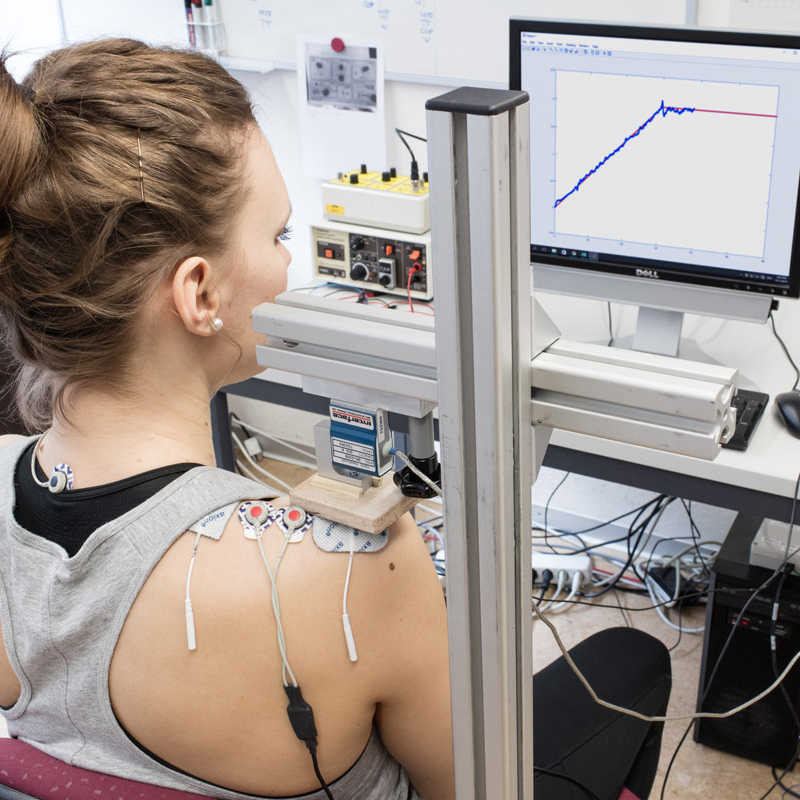Neck Muscle Fatigue after Prolonged Computer Work
In office employees, neck pain is one of the most prevalent health problems. More than 50% of all office employees suffer within one year of neck pain. Despite the high prevalence rate and several studies that were conducted, the mechanism leading to neck pain is still not fully understood.
As it is known that the activity of the trapezius muscle is involved in the development of neck pain, we use electromyography (EMG) to measure the activity of this muscle. Additionally, we measure the muscle’s twitch force, the force control and the electrocardiogram (ECG). We use a small, portable device (THUMEDI GmbH & Co. KG, Thum-Jahnsbach, Germany) that measures and saves the mentioned parameters over a long time period. Each subject participates in two experiments on non-consecutive days that last 8 hours. The subjects are seated at an adjustable workstation and perform standardized tasks designed to simulate typical aspects of modern computer work. The height of the seat, table and screen are adjusted according to standard ergonomic recommendations (see Chaffin et al. (2006)). On one of the two days, work will be randomly interrupted by short interruptions including various “distractions” that require muscle maneuvers aimed at inducing a change/disruption in trapezius muscle activity.
Publications
Müller C, Nicoletti C, Omlin S, Brink M, Läubli T. Relationship between sleep stages and nocturnal trapezius muscle activity. J Electromyogr Kinesiol. 2015 Jun; 25(3):457-62. doi: 10.1016/j.jelekin.2015.01.010. Epub 2015 Feb 12.
Nicoletti C, Müller C, Hayashi C, Nakaseko M, Tobita I, Läubli T. Circadian rhythm of heart rate and physical activity in nurses during day and night shifts. Eur J Appl Physiol. 2015 Jun;115(6):1313-20. doi: 10.1007/s00421-015-3110-3. Epub 2015 Jan 23
Nicoletti C, Müller C, Tobita I, Nakaseko M, Läubli T: Trapezius Muscle Load, Heart Rate and Time Pressure during Day and Night Shift in Swiss and Japanese Nurses. Ind Health. 2014 Mar 14. [Epub ahead of print].
Läubli Th: Arbeitsbezogene Muskel- und Skelett-Erkrankungen (MSE) – internationale Forschungsschwerpunkte. In: Grieshaber R, Stadeler M, Scholle H-Ch W (eds) Prävention von arbeitsbedingten Gesundheitsgefahren und Erkrankungen - 20. Erfurter Tage, Dez, 2013, p 405-13. Berufsgenossenschaft Nahrungsmittel und Gaststätten (BGN) Verlag Dr. Bussert & Stadeler, Leipzig, 2014.
Nicoletti C, Spengler CM, Läubli T: Physical workload, trapezius muscle activity, and neck pain in nurses' night and day shifts: A physiological evaluation. Appl Ergon. 45(3):741-6, 2014.
Funding
Swiss National Science Foundation (SNF grant 32003B_160207 “Trapezius muscle fatigue of long duration: a likely neuromuscular control issue”)
